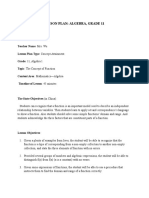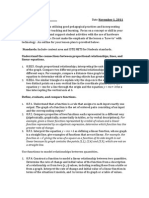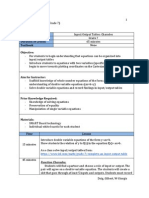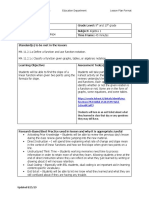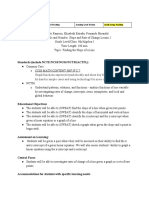Section 7 2 Lesson Plan
Section 7 2 Lesson Plan
Uploaded by
api-272198179Copyright:
Available Formats
Section 7 2 Lesson Plan
Section 7 2 Lesson Plan
Uploaded by
api-272198179Original Title
Copyright
Available Formats
Share this document
Did you find this document useful?
Is this content inappropriate?
Copyright:
Available Formats
Section 7 2 Lesson Plan
Section 7 2 Lesson Plan
Uploaded by
api-272198179Copyright:
Available Formats
Belmont Lesson Plan Template
DEPARTMENT OF EDUCATION
Building together for excellence in education
Lesson Planning Document
1. General Information
Teacher: Bethany Herdzina Subject: Algebra 2
Mentor: Stephen Dorris
Grade: Secondary
Date: 11/19/14
Time Allowed: 50
Number of Students: 25, 28
Lesson Number: 29
Lesson in Sequence: 1
Unit Title: Exponential and
Logarithmic Functions
2. Topic
Section 7.2 Inverses of Relations and Functions
3. Subjects Integrated
Algebra I
4. Readiness and Background Knowledge
In previous chapters, students have shown mastery on summative assessments in
the following areas:
o Understanding the relation between input and output values and
determining whether or not a relation is a function (Section 1.6).
o Using function notation and graphing functions (Section 1.7).
o Solving equations (Section 2.1).
Todays learning objectives are connected to what students have
previously learned.
5. Goals
CCSS.MATH.CONTENT.HSF.BF.B.4 Find inverse functions.
o CCSS. MATH.CONTENT.HSF.BF.B.4.A Solve an equation of the form
( )
for a simple function that has an inverse and write an
expression for the inverse.
o CCSS.MATH.CONTENT.HSF.BF.B.4.C Read values of an inverse
function from a graph or a table, given that the function has an inverse.
6. Objectives
Student Learning Objectives:
Students will be able to use inverse operations to write the inverse of a
function.
Given a graph of a function, students will be able to identify and graph the
inverse of that function.
Teacher Learning Objectives:
Teacher will work on encouraging student participation.
Teacher will work on staying on schedule while being flexible and allowing
for change based on students needs.
Assessment:
Formative Assessment Students will be given two questions to answer and
hand in at the end of class. This exit slip will be used as a check for
understanding, and it will help guide my instruction for tomorrows lesson.
o Exit slip problems:
1. Use inverse operations to write the inverse of the function,
( )
.
2. Students will be given the graph of the following relation:
1
3
4
5
6
0
1
2
3
5
Identify the points of the inverse function, and graph the
inverse function.
7. Resources and Materials
Demonstration materials whiteboard, Algebra II textbook, lesson plan, extra
notebook paper for the exit slip
o Written on board before class begins:
Section 7.2 homework problems
HW: pp.501-503 (#19-27 odd, 41-46 all)
Objectives:
I can write the inverse of a function.
I can graph a functions inverse.
Student materials pencil, textbook, notes journal, loose paper for the exit
slip
o 6th period IEP copy of Section 7.2 class notes
8. Instructional Model, Procedures, and Strategies
a. Attention Signal (2 minutes)
Walk to the front of the room, and greet students.
b. Opening and Advanced Organizer (no more than 13 minutes)
Call on two students and ask them what they learned from Section 7.1
yesterday.
o Because we are not having a bellringer, this will act as a brief
review of yesterdays lesson.
Answer questions from last nights homework (Section 7.1).
o Will only have time to answer one. Students can stop by during
lunch.
Introduce todays lesson.
o Section 7.2 Inverses of Relations and Functions
o By the end of the lesson, I expect everyone to be able to write the
inverse of a function and graph a functions inverse (student
learning objectives).
c. Behavioral Expectations
Students are expected to listen respectfully and participate during whole
class instruction.
d. Instructional Steps (about 25 minutes)
Graph the following relation and its inverse in different colors:
0
1
5
8
2
5
6
9
What do you notice about these two functions?
o Possible student response:
The functions show a reflection across the line
.
The - and - values are switched.
Hints:
o In a third color, dash the line
.
o Point out the symmetry.
These functions are inverses of each other.
Activate Prior Knowledge: We have seen inverses before.
o What is the additive inverse of 7?
-7
o What is the multiplicative inverse of 3?
o We also look at inverses of matrices.
As we can see from our graph, functions can have inverses too.
o Restate that the - and - values are switched, and the functions
are reflected over the line
. This will always be the case.
Example: Graph the line
and label the points (-4, -4), (-3, -2),
(-2, 0), (-1, 2), (0, 4) (graph will be handwritten into the lesson plan).
o Call on students to name a point of the inverse.
We are just switching the - and - values.
o Connect the points.
Check for Understanding: By looking at the graph of a function, how
can you graph the inverse function?
Continuation of Example:
o How can we find the equation of these lines?
We just need a point and a slope.
o Find the equations of the lines.
We know that these two functions are inverses of each other. How can
we get from
to
without looking at a graph?
o Since we are switching the - and - values, what do you think
will happen if we switch and in our equation?
o Now, we need to solve for because we want the equations of
our functions to be in terms of .
o This is how you find the inverse of a function.
Briefly discuss the notation for inverse functions.
Do another example together as a class.
o Example: Find the inverse of ( )
, and graph both
lines.
Throughout the example, call on students to give the next
steps.
1. Switch and .
2. Solve for
(students will provide steps here as well).
3. Have a volunteer come to the board to graph the
original function (graph will be handwritten on lesson
plan).
4. Have a volunteer come to the board to graph the inverse
in a different color (graph will be handwritten on lesson
plan).
Check for Understanding: How do we find the inverse of a function?
e. Lesson Closure (about 10 minutes)
Ask for two volunteers to say something that they learned today.
Exit Slip (formative assessment)
o Work the following problems on a loose piece of paper. Students will
be asked to work individually. Students will hand in their paper on
their way out of the classroom.
Exit slip problems:
1. Use inverse operations to write the inverse of the
function, ( )
.
2. Students will be given the graph of the following
relation:
1
3
4
5
6
0
1
2
3
5
Identify the points of the inverse function.
f. Feedback and Evaluation
The exit slip will be used as a check for understanding, and it will help
guide my instruction for tomorrows lesson. Based on students
understanding, I will know how much and what I need to review
tomorrow.
9. Modifications
6th period IEP copy of class notes
You might also like
- Food Delivery Business PlanDocument15 pagesFood Delivery Business PlanJoseph Muchemwa75% (4)
- System of Equations Lesson PlanDocument3 pagesSystem of Equations Lesson Planapi-489866539No ratings yet
- Factor by Grouping Lesson PlanDocument2 pagesFactor by Grouping Lesson Planapi-246371537No ratings yet
- Day 1 (Simplifying Radicals Part I) Lesson PlanDocument4 pagesDay 1 (Simplifying Radicals Part I) Lesson Planapi-272198179100% (5)
- HCPSS Secondary Mathematics Office (v2.1) Adapted From: Leinwand, S. (2009) - Accessible Mathematics: 10 Instructional Shifts That Raise StudentDocument3 pagesHCPSS Secondary Mathematics Office (v2.1) Adapted From: Leinwand, S. (2009) - Accessible Mathematics: 10 Instructional Shifts That Raise StudentJayl 22No ratings yet
- Figueroa Cortez FinishedlpDocument10 pagesFigueroa Cortez Finishedlpapi-279875150No ratings yet
- Atg in Genmath (Met 1-5)Document36 pagesAtg in Genmath (Met 1-5)Angelo GabrielNo ratings yet
- Unitplanalgebra 1Document7 pagesUnitplanalgebra 1api-243290219No ratings yet
- Lesson Plans Ed Tpa Task 1Document6 pagesLesson Plans Ed Tpa Task 1api-218854185No ratings yet
- Interdisciplinary Lesson PlanDocument13 pagesInterdisciplinary Lesson Planapi-251077176No ratings yet
- 7 1 - Area Between Two CurvesDocument2 pages7 1 - Area Between Two Curvesapi-251824010100% (1)
- Key Assessment - Parabola Lesson Plan - Revised OnceDocument7 pagesKey Assessment - Parabola Lesson Plan - Revised Onceapi-324194397No ratings yet
- Rational, and Exponential FunctionsDocument19 pagesRational, and Exponential Functionsapi-494459090No ratings yet
- Lesson 1 Factoring WeeblyDocument5 pagesLesson 1 Factoring Weeblyapi-284602462No ratings yet
- Lesson Plan 2Document9 pagesLesson Plan 2api-270322298No ratings yet
- Sample Algebra 2 Lesson Ipad ActivityDocument4 pagesSample Algebra 2 Lesson Ipad Activityapi-215517770No ratings yet
- 55 Minute Lesson PlanDocument8 pages55 Minute Lesson Planapi-295491619No ratings yet
- Lesson Plan Xuesong WuDocument6 pagesLesson Plan Xuesong Wuapi-317145143No ratings yet
- Slope InterceptDocument10 pagesSlope InterceptIzzy Joseph ZetinaNo ratings yet
- Sample Algebra CourseDocument68 pagesSample Algebra Courseapi-264733744No ratings yet
- TCNJ Lesson Plan: Aim/Focus QuestionDocument12 pagesTCNJ Lesson Plan: Aim/Focus Questionapi-253005231No ratings yet
- Instructional Project 5Document4 pagesInstructional Project 5api-317128401No ratings yet
- Day 1 Intro To Transformations Lesson PlanDocument5 pagesDay 1 Intro To Transformations Lesson Planapi-301240874No ratings yet
- LP 0109Document2 pagesLP 0109api-231961968No ratings yet
- Algebra 2 Lesson Plan 5.4Document3 pagesAlgebra 2 Lesson Plan 5.4houdini4No ratings yet
- Manhattan College Education Department Lesson Plan TemplateDocument9 pagesManhattan College Education Department Lesson Plan Templateapi-534924709No ratings yet
- Week 1: Monday Tuesday Wednesday Thursday Friday TopicDocument7 pagesWeek 1: Monday Tuesday Wednesday Thursday Friday TopicgabrieladgalvezNo ratings yet
- Lesson PlansDocument8 pagesLesson Plansapi-341104695No ratings yet
- Logarithmic Lesson PlanDocument5 pagesLogarithmic Lesson PlanAzza ZzinNo ratings yet
- Quadratic Functions r1 PDFDocument17 pagesQuadratic Functions r1 PDFalifahNo ratings yet
- Lesson Plan-Exponentials-Sadrettin OrmanDocument8 pagesLesson Plan-Exponentials-Sadrettin Ormanapi-301980453No ratings yet
- Literacy Lesson PlanDocument7 pagesLiteracy Lesson Planapi-266270177No ratings yet
- Day 3Document4 pagesDay 3api-341221569No ratings yet
- Day 7 - 2-8 Two Variable InequalitiesDocument6 pagesDay 7 - 2-8 Two Variable Inequalitiesapi-210848825No ratings yet
- Properties of Exponents Lesson PlanDocument6 pagesProperties of Exponents Lesson Planapi-285063311No ratings yet
- Lesson PlanDocument4 pagesLesson Planapi-509081529No ratings yet
- Cycle 3 Hor-PrecalDocument2 pagesCycle 3 Hor-Precalapi-262886009No ratings yet
- Lesson 7Document2 pagesLesson 7api-296884529No ratings yet
- Appendix D 1Document3 pagesAppendix D 1api-457394590No ratings yet
- Mr. Jimmy Sieng's Lesson PlanDocument2 pagesMr. Jimmy Sieng's Lesson Planapi-352681889No ratings yet
- Concordia University Nebraska Education Department Lesson Plan FormatDocument4 pagesConcordia University Nebraska Education Department Lesson Plan Formatapi-510320545No ratings yet
- 610 Lesson PlanDocument17 pages610 Lesson Planapi-334497184No ratings yet
- Lesson Plan Day 4Document8 pagesLesson Plan Day 4api-708256823No ratings yet
- Pre-Planning Questions Math Task Outline: STAGE 1: Pre-Planning (Due 2 Weeks Before You Teach)Document20 pagesPre-Planning Questions Math Task Outline: STAGE 1: Pre-Planning (Due 2 Weeks Before You Teach)api-345200895No ratings yet
- General Mathematics q1 DLLDocument54 pagesGeneral Mathematics q1 DLLRivera Kris IanNo ratings yet
- Microteach 3 Lesson PlanDocument5 pagesMicroteach 3 Lesson PlanYoungg Freedom O'Eagle SonNo ratings yet
- Finding The Slope of A LineDocument4 pagesFinding The Slope of A Lineapi-490376928No ratings yet
- Maths IGCSE AlgebraDocument3 pagesMaths IGCSE AlgebraThabang ModukaNo ratings yet
- 3rd Observation Lesson PlanDocument4 pages3rd Observation Lesson Planapi-701564760No ratings yet
- Edington Final LPDocument6 pagesEdington Final LPapi-251578516No ratings yet
- 1st Site-BasedDocument4 pages1st Site-Basedapi-311721112No ratings yet
- Section 7 4 Lesson PlanDocument6 pagesSection 7 4 Lesson Planapi-272198179No ratings yet
- Teacher: Ryan Van Omen Grade Level/Course: 9 Unit: Polynomials Topic: Interpreting and Graphing Quadratic Functions SC Content StandardsDocument4 pagesTeacher: Ryan Van Omen Grade Level/Course: 9 Unit: Polynomials Topic: Interpreting and Graphing Quadratic Functions SC Content Standardsapi-356027499No ratings yet
- Krisananuwat Up4Document3 pagesKrisananuwat Up4api-437393622No ratings yet
- Polynomial Exploration LessonDocument9 pagesPolynomial Exploration Lessonapi-281761290No ratings yet
- DocumentDocument2 pagesDocumentFuqi BhaiNo ratings yet
- Alg I Graphing Absolute Value FunctionsDocument4 pagesAlg I Graphing Absolute Value Functionsapi-401678134No ratings yet
- Van Omen Quadratics Lesson Plan 3 1Document4 pagesVan Omen Quadratics Lesson Plan 3 1api-356027499No ratings yet
- IntoductiontologslessonDocument8 pagesIntoductiontologslessonapi-249784506No ratings yet
- UBD Plan For Podcast LessonsDocument5 pagesUBD Plan For Podcast Lessonsrichardmorris16No ratings yet
- Treasure Hunt PBL UnitDocument21 pagesTreasure Hunt PBL Unitapi-272198179No ratings yet
- 8 2 (Day 3) Lesson PlanDocument3 pages8 2 (Day 3) Lesson Planapi-272198179No ratings yet
- Step-By-Step Graphic OrganizerDocument1 pageStep-By-Step Graphic Organizerapi-272198179No ratings yet
- Section 7 4 Lesson PlanDocument6 pagesSection 7 4 Lesson Planapi-272198179No ratings yet
- The Motion Pictures Ordinance 1979Document7 pagesThe Motion Pictures Ordinance 1979Ali RajNo ratings yet
- Pvc-U Pipe Class 7: (MS 762:2007) BS 3506, ASTM D1785 (SCH-80)Document1 pagePvc-U Pipe Class 7: (MS 762:2007) BS 3506, ASTM D1785 (SCH-80)kh88hmiNo ratings yet
- Create An Autumn ScrapbookDocument2 pagesCreate An Autumn Scrapbooksfarouk78No ratings yet
- The Haunting of Bly Manor: Best of 2020Document10 pagesThe Haunting of Bly Manor: Best of 2020Madoline PlattenbergNo ratings yet
- Cancer-Related Inflammation, The Seventh Hallmark of Cancer: Links To Genetic InstabilityDocument9 pagesCancer-Related Inflammation, The Seventh Hallmark of Cancer: Links To Genetic Instabilitylucia coronaNo ratings yet
- Integrated Converter With G2V V2G and DC V2V Charging Capabilities For Switched Reluctance Motor Drive-Train Based EV ApplicationDocument14 pagesIntegrated Converter With G2V V2G and DC V2V Charging Capabilities For Switched Reluctance Motor Drive-Train Based EV ApplicationhemaNo ratings yet
- Wine ProductionDocument19 pagesWine ProductionThe MatrixNo ratings yet
- (Demo Teaching) MATATAG English 7 Quarter 2 Week 2Document39 pages(Demo Teaching) MATATAG English 7 Quarter 2 Week 2VINCENT CAILING100% (5)
- Creating A New Venture TeamDocument25 pagesCreating A New Venture TeamJohnb77100% (7)
- Telephone Messages PDFDocument3 pagesTelephone Messages PDFOsborn Harry100% (1)
- Chapter9 AdvocacyAgainstCorruptionDocument17 pagesChapter9 AdvocacyAgainstCorruptionsammie helsonNo ratings yet
- Wondershare QuizCreatorDocument2 pagesWondershare QuizCreatorafdal syukriNo ratings yet
- Suman Sahu, Et AlDocument10 pagesSuman Sahu, Et AlJatin SinghNo ratings yet
- SLCM Esop Summary Notes by RS AcademyDocument3 pagesSLCM Esop Summary Notes by RS AcademyRaghavNo ratings yet
- Accomodation FormDocument2 pagesAccomodation FormAnuradha SalgatNo ratings yet
- History Motorola Annual Report Archive 1965 5p14mb 28Document28 pagesHistory Motorola Annual Report Archive 1965 5p14mb 28markymarkNo ratings yet
- Christian DatingDocument17 pagesChristian DatingJaireh CardamaNo ratings yet
- JA Poseur MACALINTANGUIDocument3 pagesJA Poseur MACALINTANGUIJOVANIE ILAONo ratings yet
- List of Training Methods: 1. Technology-Based LearningDocument10 pagesList of Training Methods: 1. Technology-Based Learningfarjana mitaNo ratings yet
- Governance What Is Governance?Document7 pagesGovernance What Is Governance?Alia KoolKatNo ratings yet
- Hanson v. Tiger Supplies - ComplaintDocument29 pagesHanson v. Tiger Supplies - ComplaintSarah BursteinNo ratings yet
- DTR Lomo Luxury 9-12 ANGDocument114 pagesDTR Lomo Luxury 9-12 ANGZlajaNo ratings yet
- Creative Platforms - Unit HandbookDocument17 pagesCreative Platforms - Unit Handbookdphotoportsmouth100% (1)
- Ice Cream CakeDocument3 pagesIce Cream CakeJosefina Carmen RoaNo ratings yet
- Majanuni Book2 Na Binta Umar AbbaleDocument39 pagesMajanuni Book2 Na Binta Umar Abbaletalktophareeda01No ratings yet
- Thomas Thomas PoovathingalDocument5 pagesThomas Thomas PoovathingalvedisreeNo ratings yet
- Counter Affidavit of Shubhnet AnanadDocument4 pagesCounter Affidavit of Shubhnet AnanadGopesh DwivediNo ratings yet
- Biography of John Sung LyallDocument229 pagesBiography of John Sung LyallNelly NEGLONo ratings yet
- Scaling Your Business For Success: Overnight Successes Are Not Always "Overnight"Document6 pagesScaling Your Business For Success: Overnight Successes Are Not Always "Overnight"Invoice Out 2No ratings yet


















